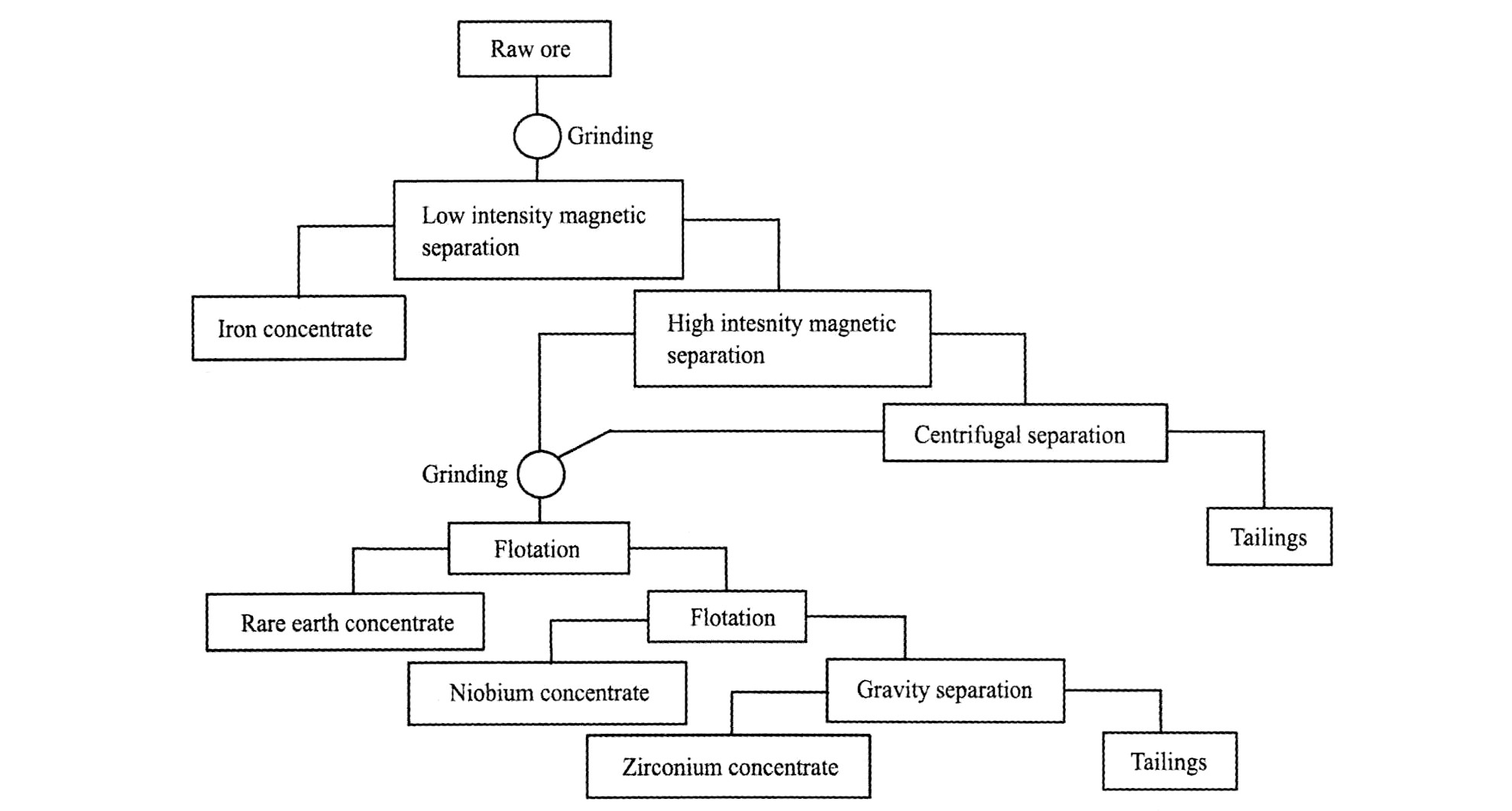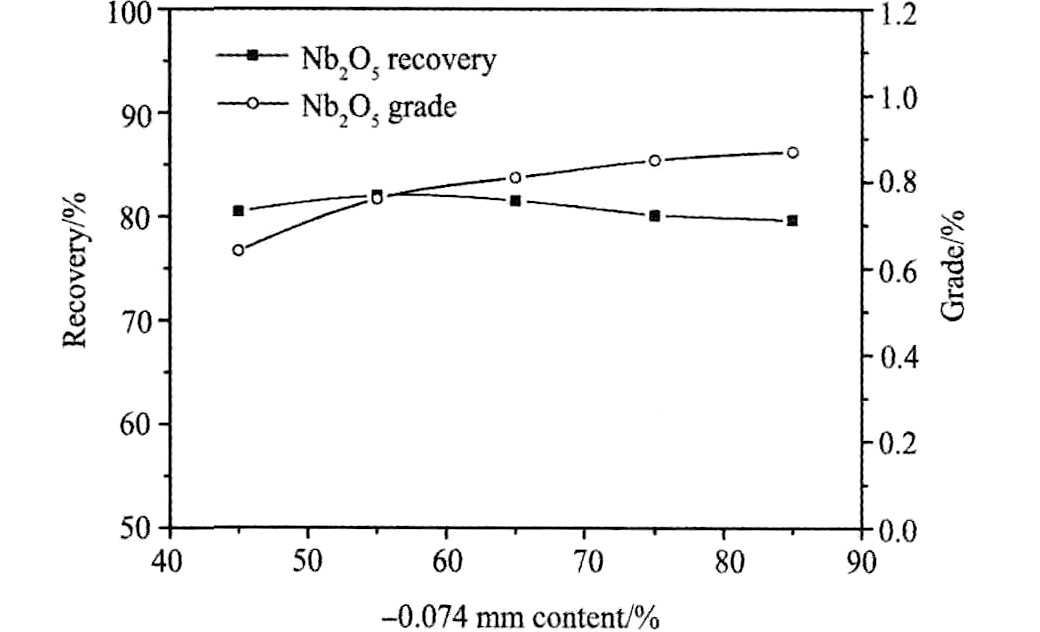某含稀土、锆复杂铌矿的选矿试验研究
北京有色金属研究总院生物冶金国家工程实验室
摘 要:
对某含稀土、锆复杂铌矿进行了详尽的工艺矿物学研究,该矿可综合回收的元素为Nb,REO,Zr。主要的含铌矿物为褐铌钇矿,主要的稀土矿物为氟碳铈矿、独居石,主要的锆矿物为锆石。矿石中有用矿物种类多,嵌布粒度较细,赋存关系复杂。根据矿石性质并从可经济利用角度考虑,进行了抛尾预富集试验和重-磁-浮精选试验,最终确定在一段磨矿细度为-0.074 mm 55%时,采用磁选-重选联合流程,可抛除68%的尾矿;预富集得到的粗精矿经过再磨后分别回收稀土、铌和锆,再磨细度为-0.048 mm 80%,采用C7羟肟酸作为稀土矿捕收剂,经过一粗一扫五精浮选可得到品位47.85%,回收率61.50%的稀土精矿;浮选稀土尾矿采用苄基胂酸作为捕收剂浮选铌,经过一粗一扫四精-磁选流程精选,可得到Nb2O5品位53.04%,回收率68.88%的铌精矿;浮选尾矿再进行重选回收锆石,经过四次重选精选,可得到ZrO2的品位40.62%,回收率为52.79%的锆精矿。
关键词:
中图分类号: TD954
作者简介:陈勇(1985-),男,湖南郴州人,硕士,工程师;研究方向:选矿;宋永胜(E-mail:sysmba@163.com);
收稿日期:2013-03-26
基金:国家科技部“十二五”科技支撑计划(2012BAB10B00)资助项目;
Beneficiation of a Complex Niobium Ore Containing Rare Earths and Zirconium
Abstract:
The process mineralogy of a complex niobium ore containing rare earths and zirconium was studied.It showed that Nb,REO and Zr could be recovered from the complex niobium ore.The main niobium mineral was fergusonite,and the main rare earth minerals were bastnaesite,monazite and xenotime.Zircon was the main mineral of element Zr.These minerals were finely disseminated and had a complex occurrence relationship in the ore.According to the nature of the ore and the perspective of economic use,a proper beneficiation process was determined.The beneficiation process contained two parts,one was discarding tailings,the other was cleaning,rough concentrate cleaning by regrinding-flotation-magnetic intensity separation-gravity concentration.In the discarding tailings stage which used magnetic intensity separation-gravity separation,the grinding fineness was-0.074 mm 55%,and produced 68% of tailing.In the stage of cleaning which used a process of flotation-magnetic intensity separation-gravity separation,the grinding fineness was-0.048 mm 80%,and the rare earths were recovered by flotation process of one roughing,one scavenging and five times of cleaning,using C7 hydroximic acid as collector;and the niobium was recovered by flotation-magnetic separation process of one roughing,one scavenging,four times of cleaning and magnetic separation,using benzyl arsonic acid as collector;and zirconium was recovered by gravity concentration flowsheet of one roughing and four times cleaning from flotation tailings.The close-circuit results showed that the grade and recovery rate of REO in the rare earth concentrate was 47.85% and 61.50% respectively;the grade and recovery rate of Nb in the niobium concentrate was 53.04% and 68.88% respectively;the grade and recovery of Zr in the zirconium concentrate was 40.62% and 52.79% respectively.
Keyword:
samarskite;fine dissemination;magnetic separation;gravity separation;flotation;
Received: 2013-03-26
| Elements | TFe | FeO | Al2O3 | SiO2 | TiO2 | MgO | Na2O | K2O | CaO |
| Content/% | 6.880 | 4.560 | 5.520 | 74.450 | 0.270 | 0.046 | 1.810 | 4.520 | 0.170 |
| Elements | Nb2O5 | REO | ZrO2 | Tl2O3 | PbO | ThO2 | Ta2O5 | ||
| Content/% | 0.340 | 1.570 | 1.750 | <0.005 | <0.005 | <0.005 | <0.005 |
铌矿床按其成因可以分为岩浆矿床、 伟晶矿床、 汽成热液矿床、 接触自变质矿床、 外生矿床等五大类
含铌的矿物种类较多, 约30多种, 具有工业利用价值的含铌矿物有黄绿石、 铌铁矿、 铌钽铁矿、 铌锰矿, 褐钇铌矿、 复稀金矿、 易解石、 铌铁金红石等
某含稀土、 锆铌矿, 矿石中伴生多种有价元素, 矿石性质复杂, 选收的矿物种类多, 综合回收价值高, 本文采用多种选矿方法对其进行综合回收利用, 以实现资源利用的最大化。
1 原矿性质研究
1.1 原矿主要化学成分分析
原矿化学分析结果见表1, 其结果表明, 该复杂铌矿中主元素铌含量为0.340%, 已达铌工业矿床指标; 另外, 该矿中伴生有价元素锆及稀土铈、 钇也具有一定的回收价值。 因此, 在回收铌的应充分回收稀土和锆。
1.2 原矿矿物组成分析
原矿矿物组成分析结果见表2。 原矿中主要含
表2 原矿矿物组成
Table 2 Mineral composition of the raw ore
| Mineral species | Content/% | Mineral species | Content/% |
| Quartz Perthite Hematite Zircon Aegirine Albite Magnetite |
48 40 3 3 2 <1 <1 |
Samarskite, Fergusonite, Xenotime, Polycrase, Monazite, Arfvedsonite, Bastnaesite, Ilmenorutile, Sericite, Mica, Kaolin, Thorite etc |
<3 |
铌矿物为褐钇铌矿(富含重稀土的铌矿物)、 复稀金矿、 铌铁金红石等; 伴生的稀土矿物有氟碳铈矿、 独居石、 磷钇矿、 胶态稀土等; 伴生的锆主要为锆石; 其他伴生的金属氧化矿物为赤(磁)铁矿、 褐铁矿; 脉石矿物主要为大量的石英、 长石, 其次是高岭土、 霓石、 钠铁闪石、 白云母等。
1.3 原矿粒度特征
采用MLA分别测定了-2 mm样品中主要铌、 稀土矿物及锆石的粒度分布, 其测定结果见表3。 由表3结果可知, 含铌矿物、 稀土矿物、 锆石的嵌布粒度集中在-0.08~+0.04 mm, -0.04~+0.02 mm, -0.02~+0.01 mm粒级。 其中, 褐钇铌矿、 铌钇矿和复稀金矿小于0.01mm的难选粒级数量分别占7.84%, 14.29%, 12.06%; -0.01 mm粒级的独居石占13.73%, 磷钇矿占16.07%, 氟碳铈矿占1.76%; 锆石在-0.01 mm粒级中稍小, 占7.52%。
1.4 主要有用矿物嵌布特征
含铌矿物褐钇铌矿在矿石中主要被复稀金矿、 磷钇矿、 锆石等矿物交代, 或蚀变为胶态稀土和金红石; 复稀金矿主要为呈浸染状分布于锆石中; 稀土矿物氟碳铈矿和独居石锆石、 铌铁金红石等连
表3 -2 mm样品中铌、 稀土矿物及锆石的粒度分布
Table 3 Niobium minerals, rare-earth minerals, zircon granularity analysis results of -2 mm sample
| Size fraction/mm |
Distribution/% | |||||||
| Fergusonite | Samarskite | Polycrase | Monazite | Xenotime | Bastnaesite | Zircon | Ilmenorutile | |
| -0.16~+0.08 | 12.00 | 26.53 | 10.00 | / | 16.32 | 20.97 | 24.90 | 38.05 |
| -0.08~+0.04 | 36.12 | 26.45 | 33.03 | 20.46 | 13.68 | 36.94 | 25.24 | 15.07 |
| -0.04~+0.02 | 33.05 | 23.72 | 26.00 | 33.44 | 32.01 | 22.60 | 23.38 | 17.59 |
| -0.02~+0.01 | 10.99 | 9.01 | 18.91 | 32.37 | 31.92 | 17.73 | 18.96 | 15.92 |
| -0.01 | 7.84 | 14.29 | 12.06 | 13.73 | 16.07 | 1.76 | 7.52 | 13.37 |
| Total | 100.00 | 100.00 | 100.00 | 100.00 | 100.00 | 100.00 | 100.00 | 100.00 |
生; 锆石主要嵌布于石英中, 部分锆石晶体中半包含褐钇铌矿。
2 选矿试验研究
2.1 选矿方案的确定
根据含铌矿物比重较大、 具有弱磁性和锆石比重较大的物理特点, 和根据含铌、 稀土、 锆矿物连生紧密的特点, 拟在粗磨条件下, 采用强磁选-重选预先脱出大量脉石, 由于矿石中含有少量强磁性矿物, 需在强磁之前预先弱磁脱出, 强磁-重选获得的粗精矿经过再磨后, 采用磁-重-浮联合流程分别回收稀土、 铌和锆石。 试验原则流程见图1。
2.2 预富集试验
预富集试验流程见图2。
2.2.1 预富集磨矿细度试验 预富集磨矿细度条件试验流程见图2, 试验条件为弱磁磁场强度为0.18 T, 强磁磁场强度为1.20 T, 磁选给矿重量浓度为15%。 试验结果见图3。 不同磨矿细度下铌矿物单体含量、 连生体含量及连生体种类见表4。 从图3试验结果可知, 随着磨矿细度的增加, 强磁和重选的混合粗精矿中Nb2O5的品位上升, Nb2O5回收率先升后降。 从表4可以看出, 随着磨矿细度的增加, 含铌矿物单体解离度增加; 含铌矿物与稀土矿物、 锆石的连生体远大于含铌矿物
图1 试验原则流程
Fig.1 Experiment of principle flowsheet
图2 预富集试验流程
Fig.2 Flowsheet of preconcentration
图3 磨矿细度试验结果
Fig.3 Experimental results of grinding fineness
表4 不同磨矿细度下铌的单体解离及连生
Table 4 Single and intergrowth of Nb in different grinding fineness
| Grinding fineness | Single/ % |
Intergrowth/% | Total/ % |
|||||||
| 4/5confluent | 3/5confluent | 1/5confluent | <1/5confluent | |||||||
| *A | *B | *A | *B | *A | *B | *A | *B | |||
| -0.074 mm 45% | 30.55 | 20.63 | 6.31 | 8.12 | 1.76 | 6.24 | 3.98 | 19.05 | 3.36 | 100.00 |
| -0.074 mm 55% | 43.71 | 20.05 | 5.03 | 6.32 | 2.98 | 7.05 | 1.36 | 12.96 | 0.54 | 100.00 |
| -0.074 mm 65% | 45.70 | 15.97 | 9.65 | 7.06 | 1.89 | 8.42 | 1.08 | 9.96 | 0.27 | 100.00 |
| -0.074 mm 75% | 48.80 | 17.83 | 9.06 | 6.34 | 2.01 | 5.78 | 0.89 | 8.17 | 1.12 | 100.00 |
| -0.074 mm 85% | 51.99 | 16.86 | 8.27 | 7.25 | 0.98 | 5.24 | 0.49 | 6.71 | 2.21 | 100.00 |
*A—represent attached with rare earth mineral and zircon; *B—represent attached with quartz, perthite and mica
与石英等脉石的连生体; 在磨矿细度超过-0.074 mm 55%后, 含铌矿物单体解离度增加较少, 且铌矿物单体解离与3/5以上连生体总量基本不变, 在磨矿细度为-74 μm 55%左右, 混合粗精矿中Nb2O5回收率达到最大。 因此, 合理预富集磨矿细度为-74 μm 55%。
2.2.2 预富集强磁磁场强度试验 预富集强磁磁场强度试验流程见图2, 试验条件为磨矿细度为-74 μm 55%, 弱磁场强为0.18 T, 给矿浓度为15%。 试验结果见图4。 从图4试验结果可知, 随着磁场强度的增加, 混合粗精矿中Nb2O5的回收率变化不大, 均在83%左右, 粗精矿Nb2O5品位先上升后下降, 在1.5~1.6 T左右粗精矿品位最高。 这可能是因为磁场强度过强, 造成脉石等非磁性矿物的夹带, 导致粗精矿品位下降。
2.2.3 预富集产品、 尾矿指标分析 在磨矿细度为-0.074 mm 55%, 强磁磁场强度为1.6 T条件下, 原矿经过磁选-重选流程处理, 各产品的产率与回收率见图5, 尾矿中稀土、 铌、 锆石的品位与回收率见图6。
从图5, 6可看出, 抛尾流程中尾矿的产率高达68%, 且尾矿中的稀土、 铌、 锆品位较低, 损失在尾矿中的稀土、 铌、 锆均未超过20%。 因此, 在粗磨条件下, 可以采用磁-重流程抛除大量尾矿。
图4 强磁磁场强度试验结果
Fig.4 Experimental results of magnetic field intensity

2.3 预富集产品分离试验
预富集产品提取稀土、 铌和锆石的试验流程见图7。
2.3.1 预富集产品再磨细度试验 预富集产品再磨细度试验流程见图7, 其中捕收剂1为C7羟肟酸, 用量300 g·t-1, 捕收剂2为苄基胂酸, 用量400 g·t-1。 磨矿细度对稀土、 铌、 锆粗精矿的影响分别见图8~10。 试验结果表明, 随着再磨细度的增加, 稀土粗精矿的品位先升后降, 回收率小幅上升; 铌粗精矿的品位和回收率均先升后降; 锆粗精矿中的品位和回收率均有所上升。 含铌矿物在不同磨矿细度下的解离度见图11。 从图11可以看出, 随着磨矿细度的增加, 矿物解离度也增加, 当磨矿细度超过-0.038 mm 85%时, 含铌矿物解离度增加不大。 综合不同磨矿细度下的矿物解离度和选矿指标, 粗精的再磨细度确定为-0.038 mm 85%。
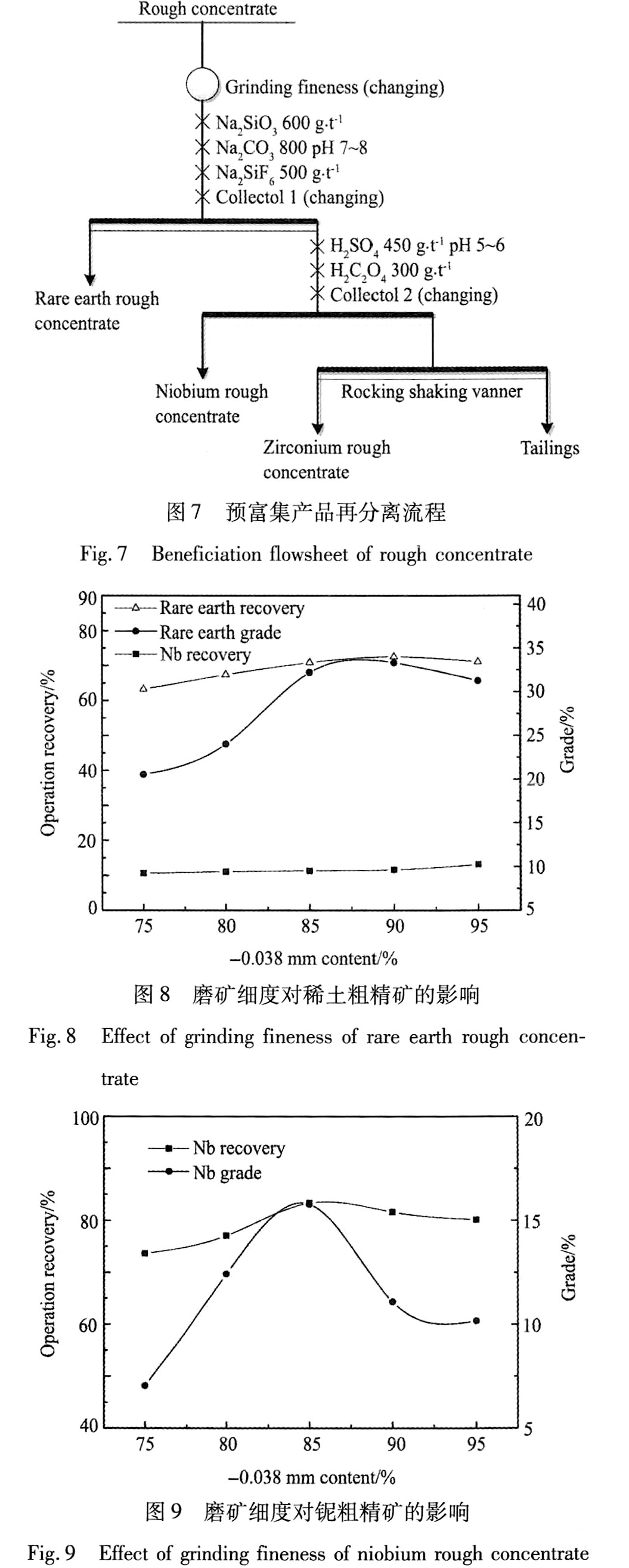
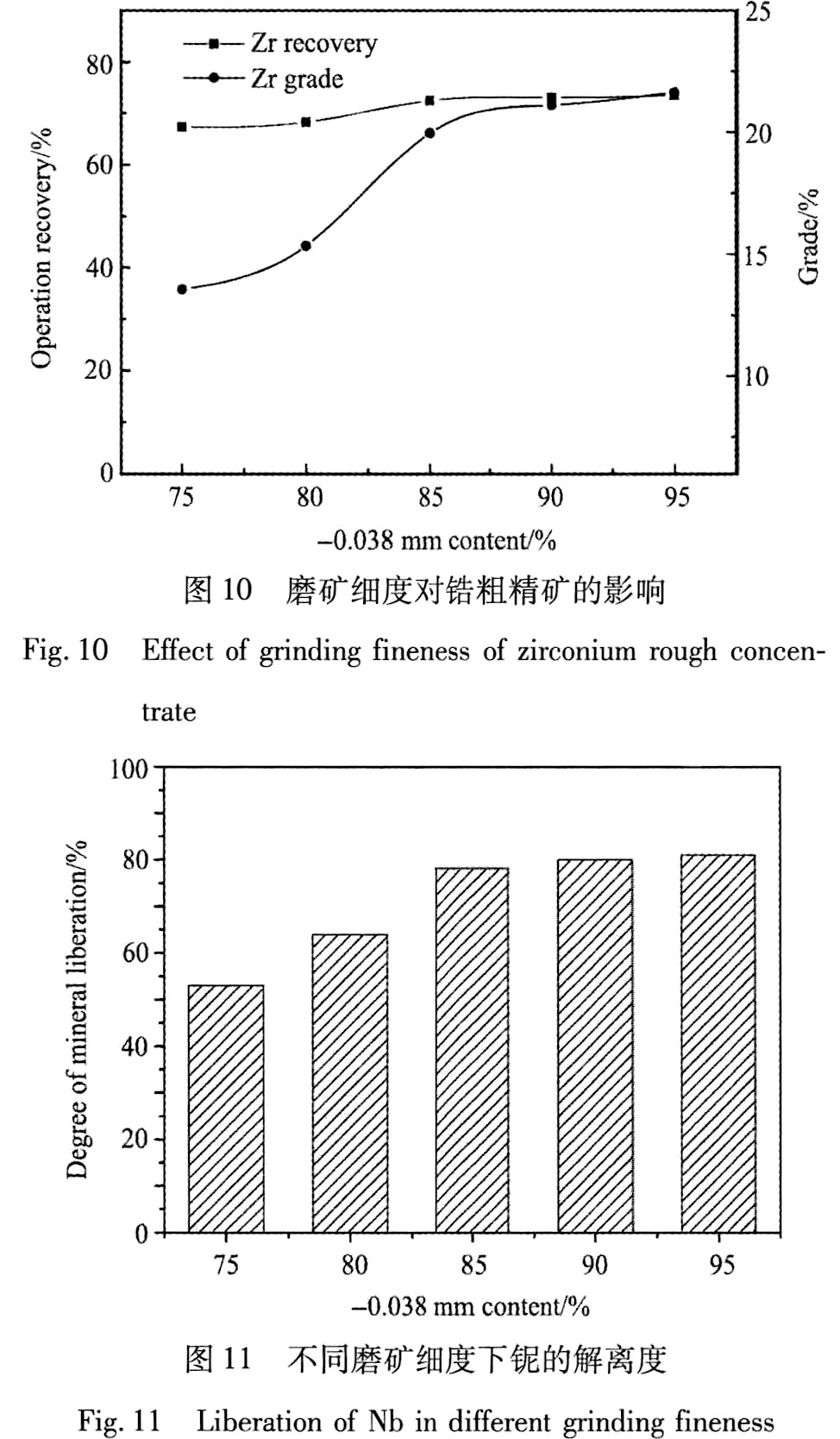
2.3.2 选稀土捕收剂用量试验 目前, 对于微细粒矿物的选矿, 浮选仍然是很重要的方法之一, 而捕收剂又是浮选过程中最为关键的因素之一。 捕收剂的性能、 用量某种程度上决定了浮选效果的好坏。 稀土矿物捕收剂有C6~9羟肟酸、 甘油单月桂酸酯单硫酸酯钠盐、 膦酸等
2.3.3 选铌捕收剂用量试验 近年来, 许多新型的浮选药剂的使用, 使一些难选的稀有金属矿选矿取得较大进展
2.4 全流程闭路试验
在前述实验的基础上, 对稀土粗精进行五次浮选精选; 对铌粗精矿精选四次后再磁选精选; 锆
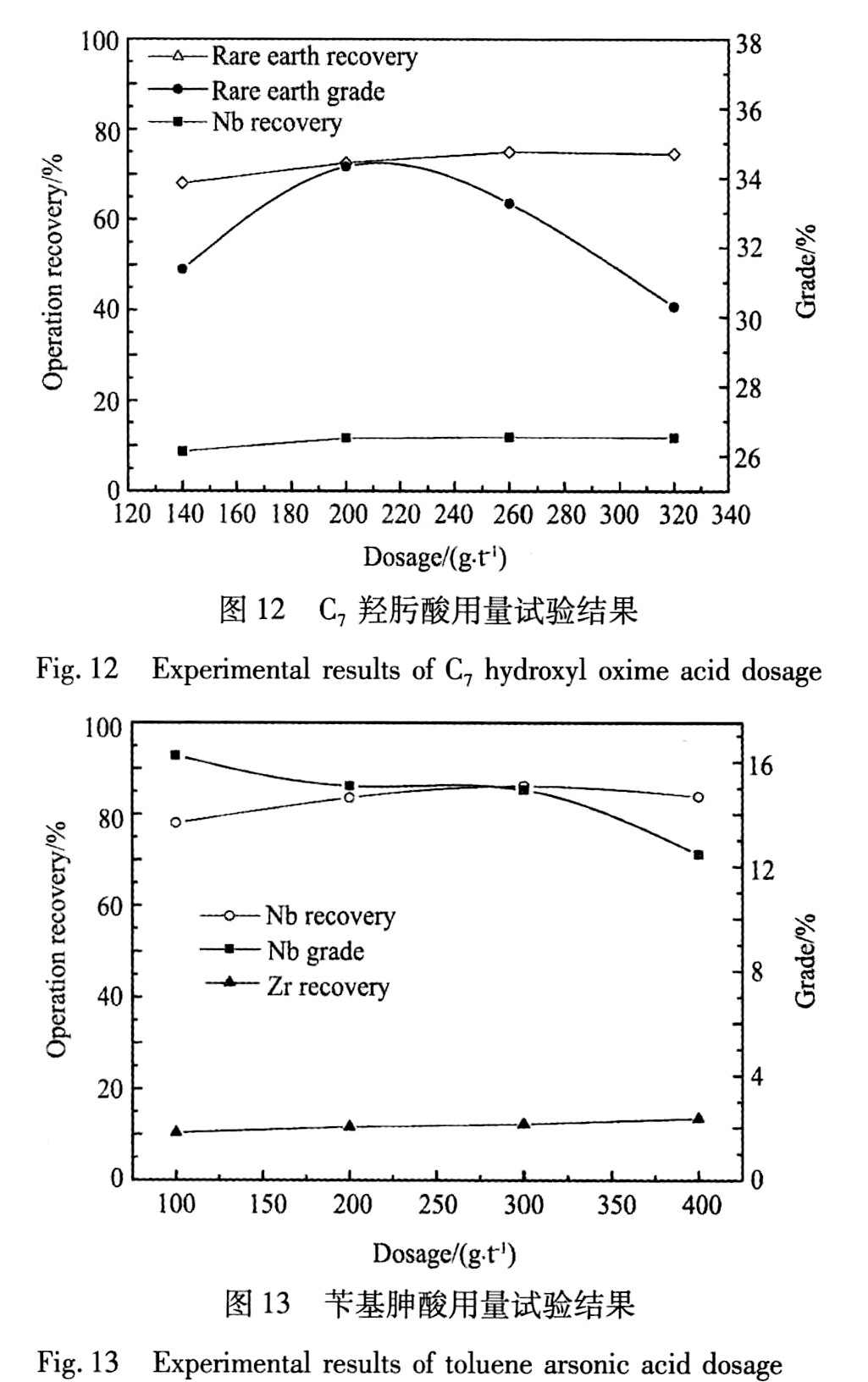
表5 闭路试验结果
Table 5 Closed-circuit test results
| Products | Yield/ % |
Grade/% | Recovery/% | ||||||
| Nb2O5 | RE2O3 | TFe | ZrO2 | Nb2O5 | RE2O3 | TFe | ZrO2 | ||
| Fe concentrate | 1.52 | 0.31 | 2.41 | 61.87 | 5.03 | 1.39 | 2.33 | 14.09 | 4.36 |
| Rare earth concentrate | 2.02 | 1.47 | 47.85 | 7.96 | 5.38 | 8.76 | 61.50 | 2.41 | 6.19 |
| Niobium concentrate | 0.44 | 53.04 | 3.68 | 26.04 | 7.67 | 68.88 | 1.03 | 1.72 | 1.92 |
| Zirconium concentrate | 2.28 | 1.06 | 2.84 | 24.85 | 40.62 | 7.13 | 4.12 | 8.49 | 52.79 |
| Tailings | 93.74 | 0.05 | 0.52 | 5.22 | 0.65 | 13.83 | 31.02 | 73.30 | 34.73 |
| Raw ore | 100.00 | 0.34 | 1.57 | 6.67 | 1.75 | 100.00 | 100.00 | 100.00 | 100.00 |
粗精进行四次重选精选。 全流程闭路试验结果见表5。
3 结 论
1. 工艺矿物学研究结果表明, 该铌矿伴生有价矿物多, 有用矿物赋存关系复杂, 大部分分布于中细粒级, 具有综合回收价值。
2. 在-0.074 mm 55%的磨矿细度下, 采用磁-重联合流程进行预富集, 可脱除68%的脉石。
3. 预富集的粗精矿再磨后, 再磨细度为-0.038 mm 85%, 在C7羟肟酸用量为200 g·t-1时, 采用一粗一扫五精浮选稀土、 可得到品位47.85%, 回收率61.50%的稀土精矿; 浮选稀土后继续采用一粗一扫四精-磁选精选, 可得到 Nb2O5 品位53.04%, 回收率68.88%的铌精矿; 浮选尾矿再进行重选回收锆石, 经过四次重选精选, 可得到ZrO2的品位40.62%, 回收率为52.79%的锆精矿。
4. 采用预富集工艺及重-磁-浮联合流程分离, 可综合回收铌、 稀土和锆。
参考文献


